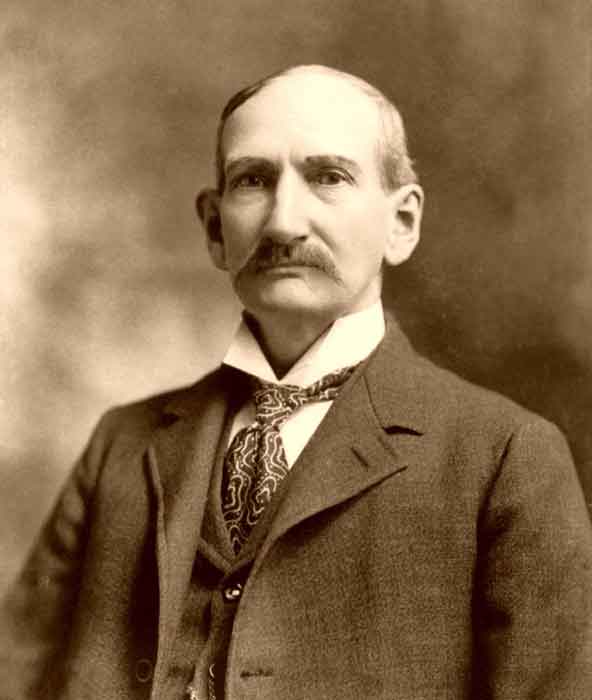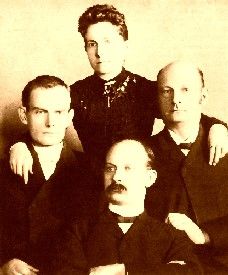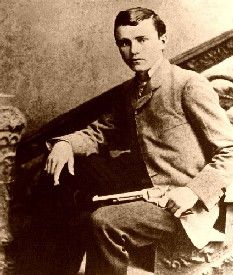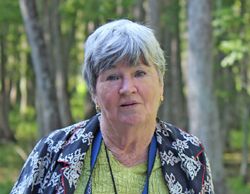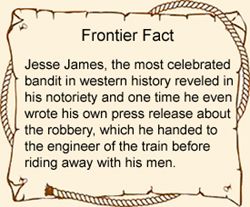By Kathleen Walls
Say “outlaw” and “James” in the same sentence, and everyone responds, “Jesse James.” It’s almost as if by dying as an outlaw in the 19th century, Jesse has far overshadowed his older brother, who died as a law-abiding entrepreneur in the 20th century.
Alexander Franklin “Frank” James and Jesse’s paths paralleled until Jesse’s death. Jesse died the demi-god of paperback novelist and later Hollywood movie moguls, dreams. He was a Confederate soldier, while still in his teens, who rode with one of the most infamous guerilla fighters of all time, William Clarke Quantrill. He refused to surrender and became an outlaw who, regardless of facts to the contrary, was considered a Robin Hood-type folk hero. The image was largely due to John Newman Edwards, an ex-Confederate major and newspaper editor.
Frank was born on the family farm near Kearney, Missouri, on January 10, 1843. He was studious and wanted to become a teacher. The turbulent times interfered with his choice of a career and sent him hurtling down a different path. Frank had a profound love of Shakespeare and carried copies of the bard’s plays in his saddlebags while being pursued by Union soldiers and later law officers. At 18, he joined General Sterling Price and fought at the Battle of Wilson’s Creek. Price, as commander of the Missouri State Guard and aided by Confederate General Benjamin McCulloch, attempted to uphold Missouri’s right to remain neutral. Frank followed Price as far as Springfield, Missouri, where he became ill and was left behind when Price, even though he had won the victory at Lexington, abandoned the entire area to Union forces. Frank was captured and forced to take an oath of loyalty to the United States.
Years later, when Frank visited Springfield as an official starter for the horse races at the annual Ozarks Empire Fair, he granted an interview to a local reporter. It appeared in the Springfield Republican on September 27, 1898.
“How well I remember that old courthouse,” Frank said, “and good cause I have to remember it. In 1862, I was a regular enlisted with General Price in the Confederate army and was with him in Springfield. I took sick with pneumonia while in this city and was placed in that old courthouse. Price retreated, and Curtis, the Yankee general, took possession of the town. As the Yankees marched by the courthouse 12 abreast, I looked out of the window and thought I would not have any comrades soon, as there were enough Yankees in Curtis’ army to kill every rebel in the south. In six weeks’ time, I was able to be about but was a prisoner and could not leave the courthouse. I then commenced to plan how to escape and, one night, managed to slip through the rear of the building (the jail part) and crawled out a window into the alley, where I found a Yankee officer’s horse, which I mounted.
“I wanted to join my regiment but was cut off from Price and knew that the chances were greatly against me if I attempted to get past the Yankees who were between me and Price, so I started north and one evening rode into Quantrill’s camp on this side of the Missouri River. I remained with Quantrill for some time and finally became one of his regulars. I stayed with him [article illegible]. I consider Quantrill, the greatest guerrilla leader. I fought the Yankees for four years and the whole world for fifteen years. I surrendered to Governor Crittenden in 1882 and was glad to lay down my guns.”
Jesse followed his brother’s footsteps and joined Quantrill’s Partisan Rangers in 1863 at the age of sixteen.
Quantrill’s men occasionally rode with the regular Confederate Army, and it was during one of these occasions that Frank acquired a lifelong friend and benefactor. On December 7, 1862, at the Battle of Prairie Grove, Arkansas, General Joseph Shelby was on the verge of being captured or shot by a Union officer when Frank came to his aid. Later, Shelby repayed the favor and proved to be one of Frank’s best friends.
Frank followed Quantrill into Kentucky in the waning days of the Confederacy and was nearby at Judge Alex Sayers’ home on May 10, 1865, when Quantrill was fatally wounded in a shootout at James Wakefield’s farm. The following morning, Frank and another Ranger, Donnie Pence, returned to the farm to see if Quantrill, who had been left at the farm after giving his word not to escape, wanted to make a run for it. Quantrill, who was now paralyzed from the waist down, refused and remained to await his fate. Frank surrendered July 26, 1865, at Samuel’s Depot in Nelson County, Kentucky.
After the war’s end, Frank joined his brother, Jesse, the Younger brothers, and some others and began a lucrative career of robbing banks and trains.
These men were not the foul-mouthed desperados often portrayed in movies but educated gentlemen who could blend into polite society. During their criminal years, they lived well and traveled extensively.
Both Frank and Jesse learned how important a good horse could be during their guerilla days. A fast, smart horse meant the difference between life and death. Both brothers were often involved with horses in Tennessee and Kentucky and financed their expensive horses with bank and train robberies. The crimes were not limited to Missouri. Their criminal trail spread from Mississippi to Minnesota.
Frank’s earliest robbery was successfully pulled off without Jesse. On February 13, 1866, Frank, Cole Younger, and approximately a dozen other men, most veterans of Quantrill’s raiders, robbed the bank at Liberty, Missouri, of money belonging to the government. One citizen, George Wymore, was killed in the course of the robbery. Jesse was still recovering from a gunshot wound received in Lexington, Missouri, where he had tried to surrender.
The James-Younger Gang did so well robbing banks that they branched out to train robberies. On July 21, 1873, they robbed the Chicago, Rock Island, and Pacific Railroad at Adair, Iowa. The engineer was killed when the train was derailed.
Frank found time for romance. On June 6, 1874, he eloped with 22-year-old Annie Ralston. Annie was the daughter of a well-to-do family in Independence, Missouri, and was unusually well-educated for her time, holding a college degree in both science and literature. She told her family she would visit family members and then disappeared on a westbound train with Frank.
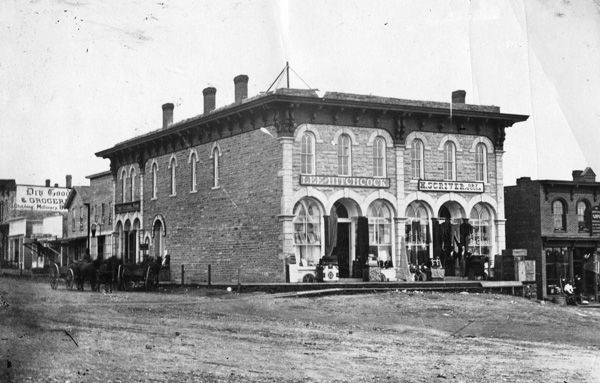
Northfield Bank, Minnesota
The marriage did not turn Frank away from his chosen lifestyle. The ill-fated robbery of the First National Bank of Northfield, Minnesota, on September 7, 1876, may have been the start of that. This was a robbery that Frank, Cole Younger, and other gang members had argued against as being too risky. Jesse James, Bob Younger, and Bill Chadwell were the instigators. The rest of the gang eventually agreed to do it: Frank, Cole, and Jim Younger, probably to protect their younger brothers.
They picked the target carefully but panicked when nothing went their way. At the bank, the cashier, Joseph Lee Heywood, refused to open the safe in spite of being pistol-whipped. They eventually cracked the safe only to discover it held $28, and when they ran from the bank, it must have looked like the entire town stood against them. Two gang members, Bill Chadwell and Clell Miller, and a bystander, Nicholas Gustavso, were killed by the crossfire. Frank, along with all three Younger brothers, was wounded.
Sloshing through the deluge with a posse of about 1,100 men pressing them hard, they decided to split up. Frank and Jesse headed west into Dakota Territory, and the Youngers and Charlie Pitts took a different trail. Frank and Jesse finally made their way into Garretson. There, according to Mark Williamson, a volunteer at Devil’s Gulch, Jesse made his famed 20-foot jump across the gorge and galloped to safety. Frank is never mentioned in this bit of folklore, but according to Bruce Rekstad, who operates the Jesse James Pontoon Ride down the Split River, “Jesse was hiding out in a cave high above the river while Frank was being treated for his wounded leg in Sioux Falls.” According to Rekstad, “There was a farm family who lived nearby at that time who said Jesse walked the bluff and asked for food, and this (pointing to the cave) is where he walked back to.”
After this, both Frank and Jesse lay low for about three years. Frank and Annie lived on Josiah Walton’s farm near Nashville, Tennessee. Anne gave birth to their only child, Robert Franklin James, on February 6, 1878. Frank appeared to be satisfied with the straight life, but Jesse was not. He visited Frank at the farm where he was living and enticed him back into the outlaw life again.
In March 1881, Jesse, along with two other men, committed one of their last robberies: an army paymaster near Muscle Shoals, Alabama. Bill Ryan, one of the robbers, was captured shortly after in Nashville and identified Jesse and Frank James as his co-robbers. Although Frank later denied taking part, it’s very believable because Frank and Jesse were known to visit a friend, John Greene Norris, in nearby Selma, Alabama.
They were becoming too notorious to feel safe anywhere. A $10,000 reward for the James boys was posted, and rumor was it meant “Dead or Alive.” Further, most of the old gang who had been with them since the war days had been killed or were in prison. The new men were of a different generation and did not have the same ties and loyalty to the gang the original members had. The gang’s final end came on April 3, 1882, when one of these new members, Bob Ford, shot and killed Jesse as he adjusted a picture on the wall of his home in Saint Joseph, Missouri.
Bob Ford and his brother, Charlie, surrendered. They were tried, Bob for first-degree murder and Charlie for aiding and abetting murder, and sentenced to hang. Missouri Governor Crittenden immediately pardoned them.
Frank knew he was living on borrowed time. On October 5, 1882, he and his friend, John Newman Edwards, met Governor Chittenden in Jefferson City. Frank surrendered his gun to Chittenden. It was agreed that Frank would not be extradited to Minnesota to be tried for the Northfield bank robbery and murder of Joseph Heywood.
In Independence, where the first trial was held, Frank was treated as a visiting celebrity instead of an accused criminal. The first charges, the murder of Pinkerton agent Joseph Whicher and the robbery of the Independence bank in 1867 were dropped due to lack of evidence.
Meanwhile, Minnesota tried to extradite Frank for the Northfield robbery, but Missouri leveled several more charges to hold him. The trial for the murder of Frank McMillan during the robbery of a Chicago, Rock Island & Pacific passenger train at Winston, Missouri, began August 21, 1883, in Gallitan. It was presided over by Judge Charles Goodman. The chief prosecutor of the state’s six-man team was William Wallace.
Frank was represented by eight of the most prestigious lawyers of the time. The lead defense attorney was former Missouri Lieutenant Governor Charles P. Johnson. None other than Frank’s old friend, General Joseph Orville Shelby, appeared as a defense witness. Shelby may have been a mixed blessing as the general was intoxicated and belligerent towards the prosecution team. He was found in contempt of court and fined $50. The weakest link in the case was the prosecution’s lead witness, Dick Liddle, a former gang member and convicted horse thief. Stacking the cards even further, every juror was a Democrat, some former Confederate soldiers. Held in the town opera house to accommodate the huge crowd of spectators, it was one of the most sensational trials of the century. Just a little over three hours after final arguments, jury foreman William Richardson returned with their verdict, “not guilty.”
Frank’s next trial was even more flamboyant. He was extradited to Alabama and went on trial in Huntsville on April 17, 1884, for the robbery of the Muscle Sholes paymaster. Frank’s train was met at the station by a cheering mob. This time, the prosecution’s lead attorney was William H. Smith, US Attorney and former reconstruction governor of Alabama. Frank’s leading defenseman was Leroy Pope Walker, former Confederate Secretary of War. The men were well-matched, but the jury was comprised mostly of Confederate veterans. Tom Carney, the editor of Old Huntsville Magazine, wrote that the James trial “was probably the biggest thing to hit Huntsville since the Civil War.”
As soon as Frank was acquitted, Missouri reclaimed him to stand trial for the Rocky Cut robbery; however, Governor Chittenden pardoned him, and Frank was now considered an innocent man free to go about living his life as a law-abiding citizen. He was wise enough to never return to Minnesota.
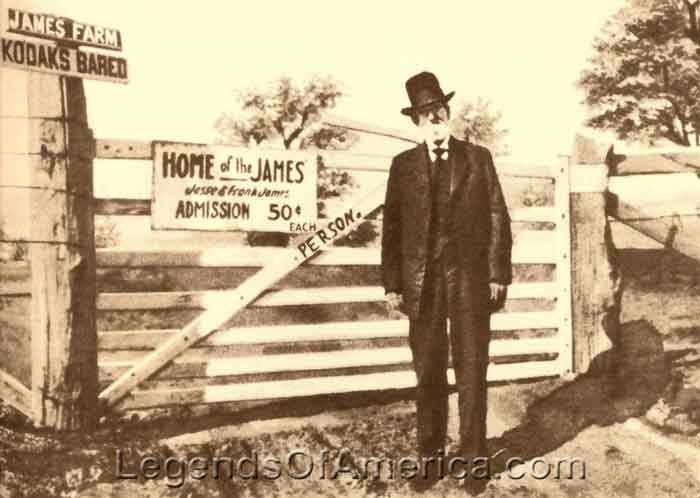
Frank James “merchandised” his past right up until the time he died. Here, he stands at the age of 70 before the gate of the Jesse James Farm, where curious spectators could pay 50¢ to see the farm and, for just a little more money, could even buy pebbles from Jesse’s grave.
However, he did travel extensively, taking a number of jobs, everything from a shoe salesman to a race starter. He often worked around horses and was sought by various race tracks in various capacities. He served as betting commissioner for Samuel Hildreth, owner of the largest racing stable at the New Orleans Fairgrounds in 1902. When his old comrade Cole Younger was released from prison, the two teamed up again to appear in The Great Cole Younger and Frank James Historical Wild West Show.
Frank bought a farm in Fletcher, Oklahoma, for a time but returned to Missouri after his mother died. Towards the end of his life, he gave tours of the Old James-Samuels Homestead for fifty cents. Frank James died a devout Christian and respected citizen on Feb 18, 1915.
© Kathleen Walls, for Legends of America, June 2016, updated January 2024.
About the Author: Kathleen Walls is the publisher and writer of “American Roads and Global Highways,” the Ezine for anyone who travels. She is also the author of travel books Georgia’s Ghostly Getaways, Finding Florida’s Phantoms, Hosts With Ghosts: Haunted Historic Hotels in the Southeast, and the Wild About Florida series, as well as several online tour guides. Her fiction books include the War in the West series, Under a Bloody Flag and Under a Black Flag, Kudzu, and Last Step, which has been made into a movie by Forbes Productions.
She has been published in “Georgia Magazine,” London, England’s “Country Music People,” “Weekender,” most of the “Visit****online.com” sites, http://www.southernusavisitor.com/, “FWT Magazine” and many others. She is a member of the International Food Wine and Travel Writers Association (IFWTWA) and the North American Travel Journalists Association (NATJA).
Also See:
Jesse James – Folklore Hero or Cold-Blooded Killer?

